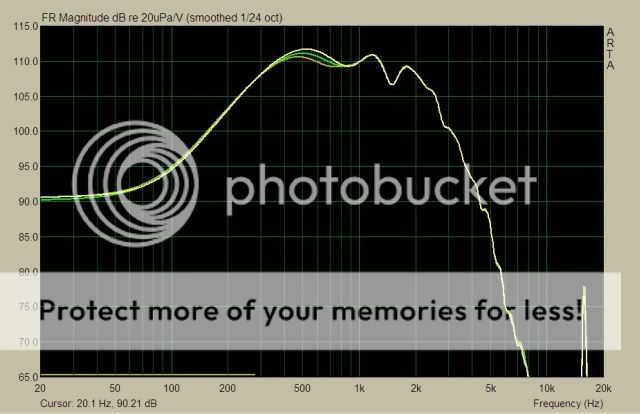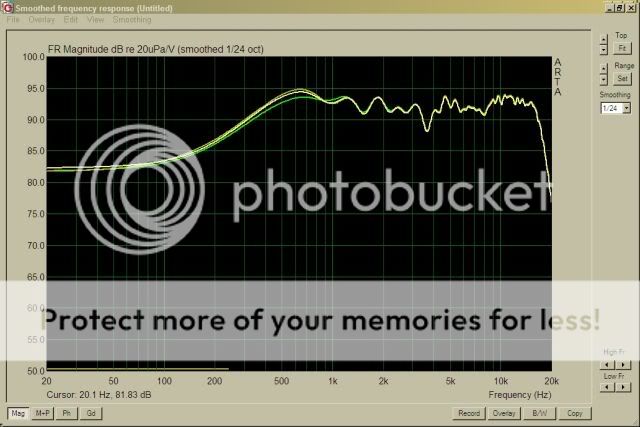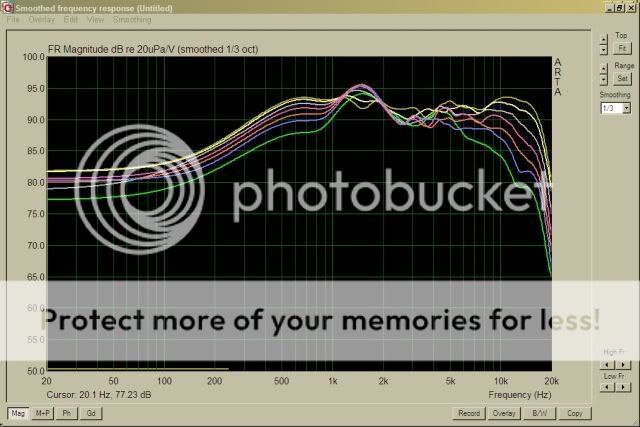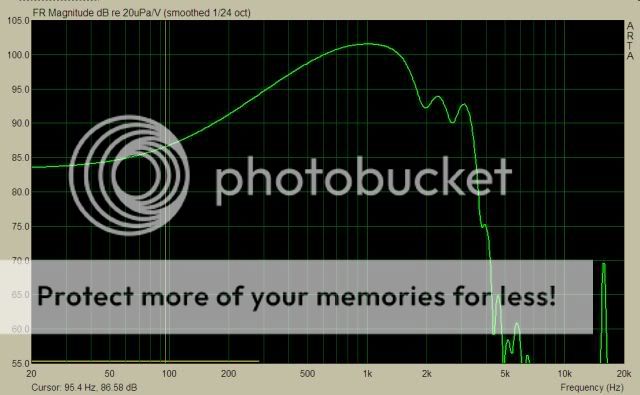Thanks for the ideas. I have looked at the factory data of Beta 8A and not too impressed with the FR and impedance plots. It seems there are alot of breakups ? Also at that price the well tested W22 or W18 are becoming more attractive. Not that I'm keento spend that much on a pair of drivers though 
The other thing is using 8" to 2-2.5kHz is really pushing it to the beaming range. Perhaps not so around 1.5kHz but I tried crossing my K1 tweeters that low and distortion was clearly audible.
I'm done with the midrange dipole EQ and it was quite forward. Played around with varous attenuation. Clearly the peak-and-dip creates a conondrum as trying to flatten the peak creates more depression on the dip. I ended up with the green one and subjectively the vocals sounds very natural.

I found the notch frequency is critical. Moved up/down 10Hz is very noticable. I just wish I had a DCX2496 to "experiment".
The other thing is using 8" to 2-2.5kHz is really pushing it to the beaming range. Perhaps not so around 1.5kHz but I tried crossing my K1 tweeters that low and distortion was clearly audible.
I'm done with the midrange dipole EQ and it was quite forward. Played around with varous attenuation. Clearly the peak-and-dip creates a conondrum as trying to flatten the peak creates more depression on the dip. I ended up with the green one and subjectively the vocals sounds very natural.

I found the notch frequency is critical. Moved up/down 10Hz is very noticable. I just wish I had a DCX2496 to "experiment".
Get a DCX2496 from the States, is not so expensive, US$250. Incl. transport cost I paid about AUD$350(local price AUD$450), that's when exchange was very good. FYI DEQX costs about AUD$4,000. I recommend you use it for testing and listening and it is very easy to resell a liitle latter once you want to build an active or passive cross-over and want to stop building speakers.The DCX is NOT PERFECT but it sounds good to me. A lot of people tends to rubbish it and I disagree. It is so easy to use.
I disagree 8" will give you beaming at 2.5khz. I use 10"and cross at 2.0Khz, no problem.
If you use a 4" driver mounted as OB you have to equalise the driver between at freq below 200-500hz before you x-over at about 200hz. My 5.5" driver in MTM config., I have to equalise between 100-300hz as well, otherwise there would be dip at that freq range. I use a low shelf filter in DCX.
I disagree 8" will give you beaming at 2.5khz. I use 10"and cross at 2.0Khz, no problem.
If you use a 4" driver mounted as OB you have to equalise the driver between at freq below 200-500hz before you x-over at about 200hz. My 5.5" driver in MTM config., I have to equalise between 100-300hz as well, otherwise there would be dip at that freq range. I use a low shelf filter in DCX.
yeah... I sometimes kick myself why not import those stuff from the states when our money was really good  anyway this is my gainDCX2000™, cost about $25 to build including all the audiophile-grade jumpers he..he..
anyway this is my gainDCX2000™, cost about $25 to build including all the audiophile-grade jumpers he..he..

The beauty with no h or u-frames is I can cross quite high at about 300hz. So that the mid is not strained.
Anyway I tried to tackle the peak issue head on and implement another notch for the midrange.

As measured it is able to bring the on-axis quite flat. The off-axis measurements are different story though:

From 300Hz up to 1kHz is real beauty. The dipole peak at about 500Hz has been equalised nicely.
The second notch which tries to equalise the peak-and-dip at about 1.2kHz is only effective on-axis. The off axis behaviour is far from ideal and this is due to the direct violation of baffle width < 2x cone diameter rule of thumb.
Tweeter starts at 2.5kHz and the off-axis behavious is quite ugly. I am not sure what the cause of this, but most likely due to the dipolar interaction with rear tweeters. As the tweeter cone is small, again the golden dipole rule is violated. This is also perhaps why after 5kHz the off-axis is a beauty again because the tweeters beam and the rear one no longer contributes to the response.
This may also explain why the midrange sound of Linkwitz pluto is unbeatable.

The beauty with no h or u-frames is I can cross quite high at about 300hz. So that the mid is not strained.
Anyway I tried to tackle the peak issue head on and implement another notch for the midrange.

As measured it is able to bring the on-axis quite flat. The off-axis measurements are different story though:

From 300Hz up to 1kHz is real beauty. The dipole peak at about 500Hz has been equalised nicely.
The second notch which tries to equalise the peak-and-dip at about 1.2kHz is only effective on-axis. The off axis behaviour is far from ideal and this is due to the direct violation of baffle width < 2x cone diameter rule of thumb.
Tweeter starts at 2.5kHz and the off-axis behavious is quite ugly. I am not sure what the cause of this, but most likely due to the dipolar interaction with rear tweeters. As the tweeter cone is small, again the golden dipole rule is violated. This is also perhaps why after 5kHz the off-axis is a beauty again because the tweeters beam and the rear one no longer contributes to the response.
This may also explain why the midrange sound of Linkwitz pluto is unbeatable.
After a few days of evaluation I conclude that the irregularities around 1k region is unacceptable. The baffle is acoustically too wide for the 5" Vifa. I was ready to go back to the previous version (S7) which uses narrow baffle, before rethinking some of the ideas given here ie. using 10" woofer as midrange.
So I simply assign the top woofer for midrange duty and this is how it measured. Very good indeed as the 2 x cone diameter rule is met, the dip falls at around 1.8k. The dipole peak was easily tamed using notch filter.

At the moment my xo is at 2.4kHz so the peak-and dip is still experienced, although nowhere near as severe as using the 5" driver. But lowering the xo to 1.5kHz later will really utilise the smooth part speaker's frequency response. I just need to get a low-FS tweeter such as 27TDFC.
In terms of subjective listening, the sound is much better. I was worried about the resolution capability of the 10" jaycar driver but that proved wrong. There is no free lunch though, and utilising 10" up to 2.4kHz is operating it at its beaming frequency. Very easily identified using pink noise, not as severe with music.
This brings back 8" as a possible "compromise". It's funny how the more I progress, the closer the design is to Orion
One other thing I learnt also, was the 10" reproduce better dynamics noticable on percussions etc., as there is more "smack" to it. I am not sure why this is the case as both 10" and 5" covers the necessary frequency range. I need to investigate this later but the probabilities are:
- the 10" have more distortion/resonance which perceived as dynamics, or
- the 5" can't move enough air to reproduce transients.
So I simply assign the top woofer for midrange duty and this is how it measured. Very good indeed as the 2 x cone diameter rule is met, the dip falls at around 1.8k. The dipole peak was easily tamed using notch filter.

At the moment my xo is at 2.4kHz so the peak-and dip is still experienced, although nowhere near as severe as using the 5" driver. But lowering the xo to 1.5kHz later will really utilise the smooth part speaker's frequency response. I just need to get a low-FS tweeter such as 27TDFC.
In terms of subjective listening, the sound is much better. I was worried about the resolution capability of the 10" jaycar driver but that proved wrong. There is no free lunch though, and utilising 10" up to 2.4kHz is operating it at its beaming frequency. Very easily identified using pink noise, not as severe with music.
This brings back 8" as a possible "compromise". It's funny how the more I progress, the closer the design is to Orion

One other thing I learnt also, was the 10" reproduce better dynamics noticable on percussions etc., as there is more "smack" to it. I am not sure why this is the case as both 10" and 5" covers the necessary frequency range. I need to investigate this later but the probabilities are:
- the 10" have more distortion/resonance which perceived as dynamics, or
- the 5" can't move enough air to reproduce transients.
gainphile said:This brings back 8" as a possible "compromise". It's funny how the more I progress, the closer the design is to Orion
What really is funny is that what you find in your el-cheapo creation (in price, NOT in sound quality!!!) as "unacceptable" (riple artefacts) seems perfecly fine for designers of a megabuck Jamo R909.
How things are relative, aren't they !
Hi,
My design procedure is as folows:
1. choose & pick drivers.
2. prototype a baffe size on which the drivers will be mounted on.
3. measure freq. response(FR), using microphone and s/w and digital x-over. If baffle too big, cut to size. If FR looks good then listen to the sound, tweak x-over freq via digiatl x-over very quick until i am happy with the sound.
4. Once the sound is satisfactory, then design a good looking cabinet to house drivers, remove digital x-over and design passive or active analog x-over to emulate FR from item 3. Or retain digital x-over.
THis procedure is very quick and without stuffing around with passive components or active analog filter, too time consuming and expensive.
Just my design procedure.
My design procedure is as folows:
1. choose & pick drivers.
2. prototype a baffe size on which the drivers will be mounted on.
3. measure freq. response(FR), using microphone and s/w and digital x-over. If baffle too big, cut to size. If FR looks good then listen to the sound, tweak x-over freq via digiatl x-over very quick until i am happy with the sound.
4. Once the sound is satisfactory, then design a good looking cabinet to house drivers, remove digital x-over and design passive or active analog x-over to emulate FR from item 3. Or retain digital x-over.
THis procedure is very quick and without stuffing around with passive components or active analog filter, too time consuming and expensive.
Just my design procedure.
gainphile said:
This brings back 8" as a possible "compromise". It's funny how the more I progress, the closer the design is to Orion
One other thing I learnt also, was the 10" reproduce better dynamics noticable on percussions etc., as there is more "smack" to it. I am not sure why this is the case as both 10" and 5" covers the necessary frequency range. I need to investigate this later but the probabilities are:
- the 10" have more distortion/resonance which perceived as dynamics, or
- the 5" can't move enough air to reproduce transients.
I think it's the second.
Think that I wanted to use a 12" for this reason. But FR is very unlikely to happen.
I still think that a carefully designed driver specifically for OB can be in the 10" size, which is the best compromise for dynamics, if using a single driver. A very good 8" in a narrow baffle can be a cheaper alternative, as there are quite a few good units in that size.
Bratislav said:
What really is funny is that what you find in your el-cheapo creation (in price, NOT in sound quality!!!) as "unacceptable" (riple artefacts) seems perfecly fine for designers of a megabuck Jamo R909.
How things are relative, aren't they !
There was a discussion at AC about Jamo. From some independent measurements, it pretty much follows the physics of small driver on wide baffle.
http://www.audiocircle.com/circles/index.php?topic=64048.msg582205#msg582205
I will reserve my opinions on systems which I never heard or measure personally. They definitely got the looks.
ttan98 said:Hi,
My design procedure is as folows:
1. choose & pick drivers.
2. prototype a baffe size on which the drivers will be mounted on.
3. measure freq. response(FR), using microphone and s/w and digital x-over. If baffle too big, cut to size. If FR looks good then listen to the sound, tweak x-over freq via digiatl x-over very quick until i am happy with the sound.
4. Once the sound is satisfactory, then design a good looking cabinet to house drivers, remove digital x-over and design passive or active analog x-over to emulate FR from item 3. Or retain digital x-over.
THis procedure is very quick and without stuffing around with passive components or active analog filter, too time consuming and expensive.
Just my design procedure.
Thanks for sharing that. I think you're really lucky to have DSP xo on-hand. I pretty much rely on breadboard. It does not take long at all to create slopes, but sometimes when working at night I needed a certain R or C value which is not in my parts bin, and it's really frustrating to wait till the next morning
For notch, I rely on software parametric equalizer + foobar. They are accurate but introduces noise. Not too much trouble though as it it so determine Q and depth mostly.
Telstar said:
I think it's the second.
Think that I wanted to use a 12" for this reason. But FR is very unlikely to happen.
I still think that a carefully designed driver specifically for OB can be in the 10" size, which is the best compromise for dynamics, if using a single driver. A very good 8" in a narrow baffle can be a cheaper alternative, as there are quite a few good units in that size.
Thanks. I am now pretty much convinced that 10" is much better in many aspects than 5". The other good news is there are plenty of good 10" out there although prices most likely doubles or triples. The Seas L series are very interesting, but with typical 3k breakup.
I lowered the XO from 2.4kHz to 1.5kHz tonight and the beaming is drastically reduced. The tweeters are strained though and audible on certain materials. Unfortunately this will rule out Neo3PDR dipole tweeter I wanted for quite sometimes ...
gainphile said:
Thanks. I am now pretty much convinced that 10" is much better in many aspects than 5". The other good news is there are plenty of good 10" out there although prices most likely doubles or triples. The Seas L series are very interesting, but with typical 3k breakup.
I'm looking for FR and there's nothing good 10", but normal midrange and wideband there's plenty.
Look at the Tone tubby, is very good up to 5k (I wouldnt cross lower).
Hi Telstar, I'm looking at the Seas.
http://www.audiophile.com.au/pdf/seas/excel/woofers_excel/e0026_w26fx001_datasheet.pdf
and
http://www.audiophile.com.au/pdf/seas/prestige/woofers/h1209_l26rfx_p_datasheet.pdf
Seems like 1.5kHz lowpass xo is very achievable with additional notches at those peaks.
Not that I will be buying them though, at $600 each I would go bankrupt. Plus, I have been listening to these $14 jaycar woofers for 2 days and can't fault them
http://www.audiophile.com.au/pdf/seas/excel/woofers_excel/e0026_w26fx001_datasheet.pdf
and
http://www.audiophile.com.au/pdf/seas/prestige/woofers/h1209_l26rfx_p_datasheet.pdf
Seems like 1.5kHz lowpass xo is very achievable with additional notches at those peaks.
Not that I will be buying them though, at $600 each I would go bankrupt. Plus, I have been listening to these $14 jaycar woofers for 2 days and can't fault them
gainphile,
without sounding too repetitive, you will find holding a whole set of values of caps, resistors and worse still inductors are very expensive. That is how Jaycar makes their money by buying individual components from them. The cost of individual components add up. You need to buy in bulk to reduce costs. Unless you are conducting ongoing development it expensive to maintain this inventory, worse still after you complete your development this inventory has no real value to others, ie difficult to sell.
I am saying because I have gone down this route before.
Cheers happy development.
without sounding too repetitive, you will find holding a whole set of values of caps, resistors and worse still inductors are very expensive. That is how Jaycar makes their money by buying individual components from them. The cost of individual components add up. You need to buy in bulk to reduce costs. Unless you are conducting ongoing development it expensive to maintain this inventory, worse still after you complete your development this inventory has no real value to others, ie difficult to sell.
I am saying because I have gone down this route before.
Cheers happy development.
Ttan, yes you are correct. It is often a false assumption to save by going cheap. Not counting the fuels etc. to go to the shop. But the problem is I don't have $450 now. But a few $ for R and C, I do. I did work with passive systems before and boy... what a waste that was 
Time alignment
The final touch to the "ASP" ... time aligning the tweeter and midrange. Nothing too dramatic here except I missed about 1mm due to lack of correct R.

What is most interesting though, is the equivalent delay is much less than physically measured distance. Which points out that the acoustic center of the woofers are not at their voice coils but much forward.
Time alignment
The final touch to the "ASP" ... time aligning the tweeter and midrange. Nothing too dramatic here except I missed about 1mm due to lack of correct R.

What is most interesting though, is the equivalent delay is much less than physically measured distance. Which points out that the acoustic center of the woofers are not at their voice coils but much forward.
gainphile said:It's funny how the more I progress, the closer the design is to Orion
Uh, I know its really fun to design and build speakers, but why don't you just get the Orion? They're not expensive. After all, isn't it unlikely that you or anyone else is going to build a superior speaker at the end of the day?
Ultima GTR said:
Uh, I know its really fun to design and build speakers, but why don't you just get the Orion? They're not expensive. After all, isn't it unlikely that you or anyone else is going to build a superior speaker at the end of the day?
err... $5000 *is* expensive
Second that $5000- would be an extravagance I would not be allowed, but by spending $55- $60 every now and again I can sneak the expense past my significant other without notice.
Also why miss out on the fun??
Ttan don't you make you on cables and interconnects?
if you buy in bulk the costs can drop quite a lot and interconnects are the part that has the least effect on the system so really big money isn't needed.
Regards
Ted
Also why miss out on the fun??
Ttan don't you make you on cables and interconnects?
if you buy in bulk the costs can drop quite a lot and interconnects are the part that has the least effect on the system so really big money isn't needed.
Regards
Ted
I hate to concede to defeat but after a few days and longer listening, it is tiring to listen to the 10" "mid"... I can only assume this is due to beaming or distortion, or both. The effect is not readily noticable, only after multiple 3+hrs listening with various materials.
I have gone back using the 5". It's not ideal and I may need to get myself an 8" one of these days. Perhaps save up to get W22 or even cheaper L22 or Peerless HDS 8". It simulates well on 30cm baffle as in phoenix/orion but even SL says it's a compromise as 1.4kHz is really on the edge of its beaming range.
I also found that operating the lower woofers (closest to the floor) induced a very strange effect. After long listening i.e. 1.5hrs+ I got really drowsy/sleepy. I remember this effect somewhat when I had the separated woofer of S7 and I thought that was due to the woofers not being aligned horizontally. I can only think the cause as low frequency information reflection to the floor. This will require further investigation.
I have gone back using the 5". It's not ideal and I may need to get myself an 8" one of these days. Perhaps save up to get W22 or even cheaper L22 or Peerless HDS 8". It simulates well on 30cm baffle as in phoenix/orion but even SL says it's a compromise as 1.4kHz is really on the edge of its beaming range.
I also found that operating the lower woofers (closest to the floor) induced a very strange effect. After long listening i.e. 1.5hrs+ I got really drowsy/sleepy. I remember this effect somewhat when I had the separated woofer of S7 and I thought that was due to the woofers not being aligned horizontally. I can only think the cause as low frequency information reflection to the floor. This will require further investigation.
gainphile said:
err... $5000 *is* expensive
I am sorry for being so insensitive. Of course that is a a lot of money. I guess I should have said that in relation to my previous systems, it is inexpensive. Your mileage may vary.
Paul
- Status
- This old topic is closed. If you want to reopen this topic, contact a moderator using the "Report Post" button.
- Home
- Loudspeakers
- Multi-Way
- S8 Open Baffle using 6 Jaycar woofers